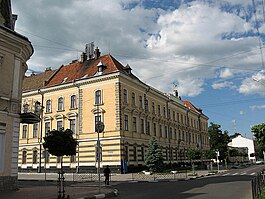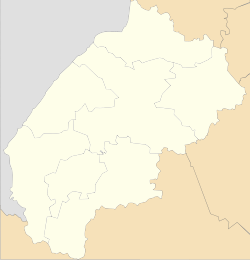|
Stryi
Stryi (Ukrainian: Стрий, IPA: [strɪj] ⓘ; Polish: Stryj) is a city in Lviv Oblast, western Ukraine. It is located in the left bank of the Stryi River, approximately 65 kilometres (40 mi) south of Lviv in the foothills of the Carpathian Mountains. It serves as the administrative center of Stryi Raion within the oblast. Stryi also hosts the administration of Stryi urban hromada, one of the hromadas of Ukraine.[1] Its population is approximately 59,425 (2022 estimate).[2] Name The city takes its name from that of the river Stryi, a tributary of the Dniester.[citation needed] The river's name is very old and means "stream".[3] Its etymology stems from the Indo-European root *sreu. [note 1] The area was inhabited by the White Croats and it has been established that name Horvat (Croat) is likewise of Iranian (Sarmatian) origin.[citation needed] In different times the name was written differently, and in various old documents we can find such names: Stryg, Stry, Stryj, Stryjn, Stryjia, Strig, Strigenses, Stryi, Strey, Striig, Strya, Sthryensis, Sthrya, Stryei, and Stri. The inhabitants take pride in the fact that the city has managed to keep its original name over time.[citation needed] History   Stryi was mentioned for the first time in 1385 (see: Red Ruthenia). Its territory was annexed to Poland following their invasion and conquest of Galicia. In 1387 the Polish king Jogaila gave the city as the present to his pro-Tsarist brother Švitrigaila. In 1431 it was given the Magdeburg Rights, and it was located in the Ruthenian Voivodeship, which from the conquest in the 14th century until 1772 was a part of Poland.[4] The city was governed by the local magistrate headed by a burgomaster. Following the Partitions of Poland the territory and all Galicia fell to the Austrian Empire. Its geographical location had a positive influence on its development and growth. The city became a flourishing trade center being located on the major trade route between Halych and Lviv (Lemberg) and especially during the 15th to 16th centuries. It was destroyed during one of the Tatar raids in 1523. The city was later rebuilt and included a castle for defence purposes which later in the 18th century was dismantled by the Austrian authorities. In 1634 the city was destroyed once again by another Tatar raid. During the Khmelnytsky Uprising the Cossack Hetmanate army was reinforced by Hungarian regiments of Prince Rákóczi of Transylvania. After the partition of the Polish–Lithuanian Commonwealth in 1772 the city became a part of the Austrian Empire (see: Partitions of Poland). During the revolutionary times in the Empire a Ruthenian Council was created in the city in 1848. During 1872-1875 the city was connected to the Austro-Hungarian railroad network. Its first train station was built in 1875. Around this time industrialisation began. Among the most influentual citizens of the city were Doctor Yevhen Olesnytsky, Father Oleksa Bobykevych, and Father O.Nyzhankivsky[citation needed]. In 1886 a large fire burnt almost the entire city to the ground. From October 1914 to May 1915 Stryi was occupied by the Russian Empire. In 1915 a bloody World War I battle took place in the nearby Carpathian Mountains, around the peak of Zwinin (992 metres above sea level), a few kilometres south of Stryi in which some 33,000 Imperial Russian soldiers perished. On 1 November 1918, an armed uprising took place in the town, after which it became a part of the short-lived West Ukrainian People's Republic. Stryi was again annexed by Poland in May 1919 during another invasion. In 1939, following the Soviet Union's invasion of eastern Poland, Stryi became part of the Ukrainian SSR. (see: Polish September Campaign). In interbellum Poland, it was the capital of the Stryj County (area 2,081 square kilometres (803 sq mi), pop. 152,600) of the Stanisławów Voivodeship. According to the Polish census of 1931, its population consisted of 35.6% Jews, 34.5% Poles, 28% Ukrainians and 1.6% Germans.[5]  In July 1941, the Germans invaded all Galicia, including Stryi. In a short time, Ukrainians and local Poles conducted a pogrom in the Jews of the settlement, killing about 300 people. Between then and August, 1943, the Germans, with the assistance of the Ukrainian police, are said to have murdered most of the town's 11,000 Jews in a nearby forest or rounded them up to be sent to Belzec extermination camp.[6] Of a pre-war population of 11,000, only a few Jews survived.[7] During the Cold War the town was home to Stryy Air Base. Stryi was the first city in Ukraine to display the Ukrainian flag, when it was hoisted at the Stryi city hall on 14 March 1990, before the December 1991 implosion of the Soviet Union.[citation needed] Recent historyOn 9 April 2009, the Lviv Oblast council decided to remove a Soviet-era statue to the Red Army soldier that was installed by the local Communist regime in the city of Stryi and move it to a museum of the Soviet totalitarianism, saying that the statue carries no historical or cultural value to the city. Until 18 July 2020, Stryi was incorporated as a city of oblast significance and served as the administrative center of Stryi Raion even though it did not belong to the raion. In July 2020, as part of the administrative reform of Ukraine, which reduced the number of raions of Lviv Oblast to seven, the city of Stryi was merged into Stryi Raion.[8][9] Population
Notable people Notable people born in Stryi include:
Twin towns – sister cities
Other forms of cooperation
Notes
Sources
External linksWikimedia Commons has media related to Stryi.
|
|||||||||||||||||||||||||||||||||||||||||||||||||||||||||||||||||||||||||||||||||||||||||||||||








